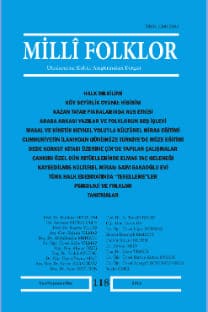TÜRK HALK EDEBİYATINDA “TESELLEME”LER
Türk sözlü geleneğinde “teselleme”ler, konuşma sırasında misal vererek konuyu açıklama, des-tekleme amacıyla anlatılan düşündürücü, ders verici, nükteli, kısa öykülerdir. Teselleme, fıkra türü-ne çok benzemekle birlikte ondan farklı birtakım özelliklere sahiptir. Konuşma sırasında “teselleme getiren” kişi, anlattığı öykünün kahramanlarını tanır, hatta bizzat kendisi olayın kahramanı veya tanığıdır. Bu bakımdan tesellemeler, fıkra türünün oluşumunun alt basamaklarını teşkil eder. Öykü, kahramanları gerek anlatıcı gerekse de dinleyici tarafından yakından veya uzaktan tanınmaksızın, ortaya çıktığı bölgenin dışında, kahramanlarının adları değiştirilerek veya bilinen fıkra tiplerine dö-nüştürülerek anlatılmaktaysa teselleme olmaktan çıkıp fıkra hâline gelmektedir. Örneklerine en çok İç Anadolu Bölgesi’nde rastladığımız tesellemelerin, fıkraların oluşumunu hazırlayan çekirdek anla-tılar olduğu söylenebilir. Şekil yönünden fıkralara benzeyen tesellemeler konuşma dilinde, yalın, kısa nesir anlatılardır. Bununla birlikte kimi yörelerde, öykü içerisinde, belirli bir şekli olmayan, uyaklı, tekerleme benzeri, “yakıştırma” adı verilen parçalara rastlanabilmektedir. Genellikle nükteli veya özlü bir söz ile biten tesellemeler, fıkralarda olduğu gibi, kimi deyim ve atasözlerinin ortaya çıkmasına da kaynaklık eder. Tesellemeler, tek başlarına durup dururken anlatılmaz; konuşma esnasında yeri geldiğinde, bir vesile ile anlatılırlar. Konuşma esnasında tesellemelere yer verme işine halk arasında “teselleme getirme”, “tesellemede bulunma” denilmektedir. Herkes teselleme getirebilir, ancak kimi hoşsohbet, nüktedan, hazırcevap kişiler vardır ki, konuşmalarında sık sık tesellemelere yer verirler. Böyle kişilere “tesellemeci” denilmektedir. Halk arasında böylesine yaygın olan tesellemeler üzerine yapılmış derleme, araştırma ve inceleme yeterince bulunmamaktadır. Bu çalışmanın amacı halk ede-biyatı araştırmacıları tarafından yeterince ele alınmamış olan tesellemelerin özellikleri, oluşum aşa-maları, kullanım alanları, icracıları ve icra ortamları hakkında bilgi sunmaktır.
“Teselleme”s in Turkish Folk Literature
“Teselleme”s in Turkish folk literature are thought-provoking, didactical, witty, shorts stories which are told in order to explain and support topics by giving examples. While it’s very similar to anecdotes, tesellemes have certain different features. During the conversation, the person who “gives tesellemes” knows the heroes of the narrative he is talking about, even the person himself is the hero or witness of the event. In this regard, the tesellemes constitute the lower steps of the formation of the anecdotes. If the heroes are told either by the narrator or by the listener without being recognized closely or remotely and by changing the names of the heroes or transforming them into known types of ancdotes, the story turns into an anecdote instead of being a teselleme. “Teselleme”s, whose samp-les are mostly seen in Central Anatolia Region, are claimed to be the core narratives which prepare the formation of the anecdotes. Tesellemes which resemble the anecdotes in terms of shape are plain, short prose in spoken language. However, in some regions, certain rhyming pieces which do not have a certain shape and which resembles rhymes,which are called “matching”, can be met in the stories. Tesellemes that often end in a witty or concise word are also sources of some idioms and proverbs, just as anecdotes. Teselleme is not told alone, it is told on one occasion during the conversation. The task of giving place to tesellemes during the speech is called “bringing teselleme” or “giving teselleme” among the people. Everyone can bring teselleme, but there are some who are sociable, witty, and ready-to-talk, they often give places to tesellemes in conversation. Such persons are called “tesellemeci”. There are not enough compilations, researches and investigations on tesellemes that are so common among the people. The aim of this study is to provide information about the characteristics, formation stages, usage areas, performers and enforcement environments of the teselleme that has not been adequately addressed by folk literature researchers.
___
- Artun, Erman. Ansiklopedik Halkbilimi/Halk Edebiyatı Sözlüğü. Adana: Karahan Kitabe-vi, 2014.
- Avcı, Haydar. “Hançılı’dan Derlemeler: I / Te-sellemeler”. Halk Kültürü 1985/ 3-4 (1986): 9- 10.
- Coşkunsoy, Habib. Yozgat Tesellemeleri. Ankara: Kültür Ajans Yayınları, 2012.
- Derleme Sözlüğü (10. Cilt). Ankara: Türk Dil Kurumu Yayınları, 1993: 3896.
- Erbaş, İbrahim. Kırşehir Dalakçı Köyü Sözvar-lığı-Folklor-Geçmiş Günler. Ankara: Ürün Yayınları, 2015.
- http://ns.turktube.com (Erişim Tarihi: 15 Ocak 2018).
- http://wowturkey.com Erişim Tarihi: 15 Ocak 2018).
- Işık, Ramazan. “Hayata Dair / Nasıl Bir Kadın” http://rmazan.blogspot.com/2013/06/na-sil- bir-kadin.html (Erişim Tarihi: 15 Ocak 2018).
- Kaya, Doğan. Ansiklopedik Türk Halk Edebiyatı Terimleri Sözlüğü. Ankara: Akçağ Yayınları, 2010.
- Özer, Kenan. “Bir Yörük Tesellemesi”. 2009. Yastı, Mehmet. “Derleme Sözlüğü’nde Geçen Atasözü, Bilmece, Hikâye ve Masal Türleri-nin Adlandırılma Şekilleri ve Kökenleri Üze-rine Bir Değerlendirme”. SUTAD 39 (Bahar 2016): 213-227.
- Yüksel, Hasan. “Bünyan Yöresi Çocuk Oyunla-rından Derlenen Tekerlemeler”. Erciyes Ay-lık Fikir ve Sanat Dergisi. 405, Eylül 2011.
- ISSN: 1300-3984
- Yayın Aralığı: Yılda 4 Sayı
- Başlangıç: 1989
- Yayıncı: Geleneksel Yayıncılık Eğitim San. Tic. Ltd. Şti.
Sayıdaki Diğer Makaleler
AİZANOİ’DA MASAL VE KİNETİK HEYKEL YARDIMIYLA KÜLTÜREL MİRAS EĞİTİMİ
KAYBEDİLMİŞ BİR KÜLTÜREL MİRAS: SAİM SAKAOĞLU EVİ/KONYA
ÇANKIRI ÖZEL GÜN RİTÜELLERİNDEKİ ELMAS TAÇ GELENEĞİ
DEDE KORKUT KİTABI ÜZERİNE ÇİN`DE YAPILAN ÇALIŞMALAR VE ELEŞTİREL DEĞERLENDİRİLMESİ
BEREKET, EĞİTİM, EĞLENCE ÜÇGENİNDE BİR KÖY SEYİRLİK OYUNU: HİBİBİM
DİL POLİTİKALARI BAĞLAMINDA RUS ETKİSİNİN KAZAN TATAR FIKRALARINA YANSIMASI
Robert Ranulph MARETT, Didem Gülçin ERDEM
TÜRK HALK EDEBİYATINDA “TESELLEME”LER
